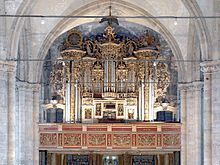Johann Christoph Wiedemann
Johann Christoph Wiedemann (born December 19, 1730 in Stolberg (Harz) , † January 1794 ) was a German organ builder .
Life
Johann Christoph Wiedemann worked for Johann Adolarius Papenius and took over the organ workshop from Papenius in Halberstadt around 1761 , since Papenius probably had no children who could carry on the organ building tradition of his family. In 1768 Wiedemann repaired the organ in the St. Jacobi Church in Göttingen, and in the same year he made a cost estimate for the St. Albani Church . In 1769 the organ in St. Sixti Church was repaired by Johann Heinrich Gloger (1721) in Northeim because of its poor condition .
In 1770, on the orders of the Prussian King Friedrich II, the so-called Gröningen organ was taken from Gröningen Castle , which was to be demolished, to Halberstadt in the St. Martini Church , where Andreas Werckmeister had been the organist half a century earlier . Wiedemann was commissioned with this work after Papenius had inventoried the organ. Wiedemann built nine new registers and a glockenspiel into the instrument. In addition, "ears" were attached to both sides of the pedal towers with two drum beaters and some decorative elements.
In 1774, the Kroppenstedter pastor Christoph Herman wrote to the Prussian king, the then sovereign, for support for an urgently needed repair of the organ, consecrated in 1613, by Esaias Compenius the Elder of the St. Martini Church in Kroppenstedt. The royal consistory demanded that in addition to the organ builder Schlesinger (Johann Michael Schlesier (1718–1788) is probably referring to) from Halberstadt, who had already made a cost estimate, the organ builder Johann Christoph Wiedemann should also make a plan. After examining the instrument, Wiedemann wrote:
- Pfeiff work in the whole organ is very damaged, some are missing, some do not sound at all, especially the pipe work does not respond at all. The pompes in the windchests are very damaged, causing the wind to go away. There are also some errors in the abstract and registry. The bellows are completely ruined, they have to be gutted and covered with new leather, the whistlework taken apart and cleaned of dust and dirt.
In 1774, at the orders of the consistory, Johann Christoph Wiedemann repaired the organ at the expense of the parish.
In 1776 he repaired the organ of the St. Trinitatis Church in Derenburg .
Until 1792 he built, expanded and maintained the organ built by Papenius in Rohrsheim . Wiedemann probably died in Halberstadt in January 1794.
plant
The size of the instruments is indicated in the fifth column by the number of manuals and the number of sounding registers in the sixth column. A capital “P” stands for an independent pedal , a lowercase “p” for an attached pedal. Italics indicate that the organ in question is no longer preserved.
| year | place | building | image | Manuals | register | Remarks |
|---|---|---|---|---|---|---|
| 1761 | Huysburg | Monastery church |

|
II / P | 27 | Begun in 1760 by Papenius, finished in 1761 by Wiedemann; 1983 new work installed by the organ building company Eule from Bautzen; Housing is preserved. |
| 1763 | Vogelsdorf | St. Nikolai village church | Construction was based on a cost estimate from Papenius from 1761; in 1859 the organ was replaced by organ builder Richard Voigt from Halberstadt | |||
| 1766 | Krottorf | St. Severi | ||||
| 1768 | Cutters | Saint Sixti Church | 1795 new building by Christian Boden | |||
| 1777/1778 | Neindorf | Castle Church | Pictures of the organ → [1] | II / P | 23 | Restored in 2010/2011, including reinstallation of the glockenspiel and removal of pipes that were installed later; Probably the only surviving, newly built organ from Wiedemann |
| 1787 | Staßfurt | church | Costs 417 Rthl. |
literature
- Uwe Pape, Alfred Schirge: North German organ builders and their works. Volume 3: The organ building family Papenius and their students (Georg Benedikt Papenius, Johann Georg Papenius, Johann Adolarius Papenius, Johann Christoph Wiedemann, Johann Michael Schlesier, Christoph Jesse). Pape, Berlin, 2005.
Individual evidence
- ^ Karl Heinz Bielefeld: Organs and Organ Builders in Göttingen. Pape, Berlin, 2007, p. 152 and p. 136.
- ^ History of the Northeim Organ
- ↑ History of the Groeninger Organ
- ^ History of the Compenius organ in Kroppenstedt
- ↑ Uwe Pape, Alfred Schirge: The organ builder family Papenius and their students Pape, Berlin, 2005, p. 119.
- ↑ Stepanus Kunze: History, statistics and topography of all the localities of the district of Oschersleben Häniche, Oschersleben, 1842, p. 247.
- ^ Uwe Pape: The Boden Pape family of organ builders , Berlin, 2006, p. 292.
- ↑ Article on the reconstruction of the Wiedemann organ in the Neindorf Castle Church
- ^ Friedrich W. Geiss: Chronicle of the city of Staßfurt and the surrounding area Döring, Calbe, 1837, p. 247.
| personal data | |
|---|---|
| SURNAME | Wiedemann, Johann Christoph |
| BRIEF DESCRIPTION | German organ builder |
| DATE OF BIRTH | December 19, 1730 |
| PLACE OF BIRTH | Stolberg (Harz) |
| DATE OF DEATH | January 1794 |

